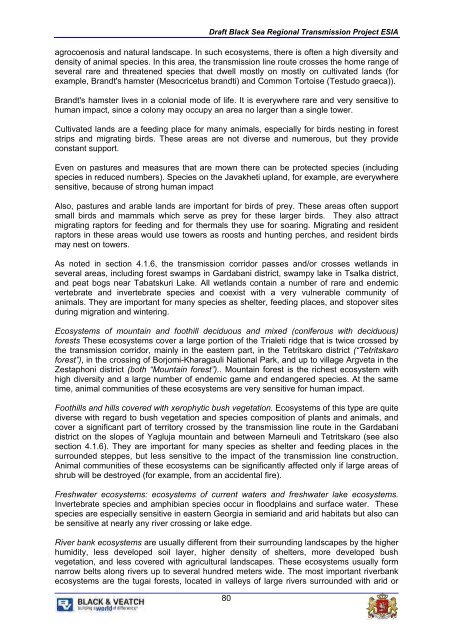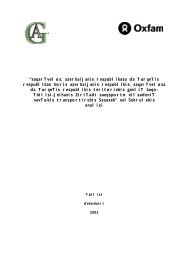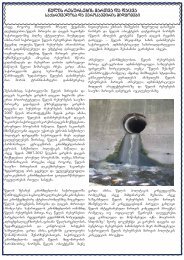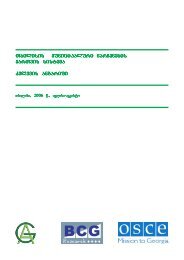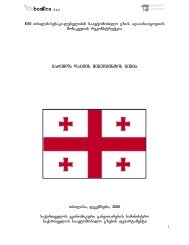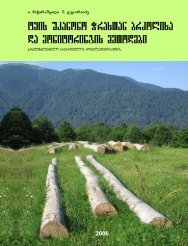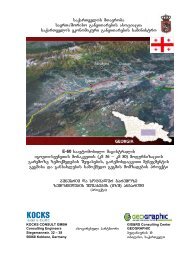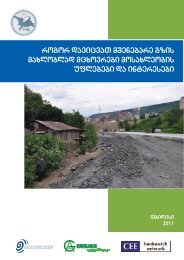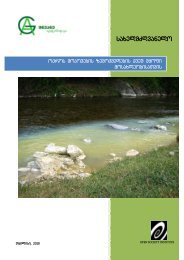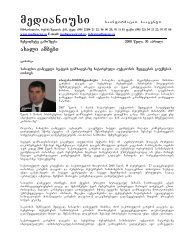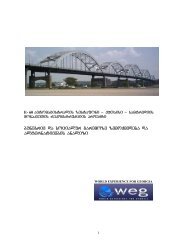Part I
Part I
Part I
You also want an ePaper? Increase the reach of your titles
YUMPU automatically turns print PDFs into web optimized ePapers that Google loves.
Draft Black Sea Regional Transmission Project ESIA<br />
agrocoenosis and natural landscape. In such ecosystems, there is often a high diversity and<br />
density of animal species. In this area, the transmission line route crosses the home range of<br />
several rare and threatened species that dwell mostly on mostly on cultivated lands (for<br />
example, Brandt's hamster (Mesocricetus brandti) and Common Tortoise (Testudo graeca)).<br />
Brandt's hamster lives in a colonial mode of life. It is everywhere rare and very sensitive to<br />
human impact, since a colony may occupy an area no larger than a single tower.<br />
Cultivated lands are a feeding place for many animals, especially for birds nesting in forest<br />
strips and migrating birds. These areas are not diverse and numerous, but they provide<br />
constant support.<br />
Even on pastures and measures that are mown there can be protected species (including<br />
species in reduced numbers). Species on the Javakheti upland, for example, are everywhere<br />
sensitive, because of strong human impact<br />
Also, pastures and arable lands are important for birds of prey. These areas often support<br />
small birds and mammals which serve as prey for these larger birds. They also attract<br />
migrating raptors for feeding and for thermals they use for soaring. Migrating and resident<br />
raptors in these areas would use towers as roosts and hunting perches, and resident birds<br />
may nest on towers.<br />
As noted in section 4.1.6, the transmission corridor passes and/or crosses wetlands in<br />
several areas, including forest swamps in Gardabani district, swampy lake in Tsalka district,<br />
and peat bogs near Tabatskuri Lake. All wetlands contain a number of rare and endemic<br />
vertebrate and invertebrate species and coexist with a very vulnerable community of<br />
animals. They are important for many species as shelter, feeding places, and stopover sites<br />
during migration and wintering.<br />
Ecosystems of mountain and foothill deciduous and mixed (coniferous with deciduous)<br />
forests These ecosystems cover a large portion of the Trialeti ridge that is twice crossed by<br />
the transmission corridor, mainly in the eastern part, in the Tetritskaro district (“Tetritskaro<br />
forest”), in the crossing of Borjomi-Kharagauli National Park, and up to village Argveta in the<br />
Zestaphoni district (both “Mountain forest”).. Mountain forest is the richest ecosystem with<br />
high diversity and a large number of endemic game and endangered species. At the same<br />
time, animal communities of these ecosystems are very sensitive for human impact.<br />
Foothills and hills covered with xerophytic bush vegetation. Ecosystems of this type are quite<br />
diverse with regard to bush vegetation and species composition of plants and animals, and<br />
cover a significant part of territory crossed by the transmission line route in the Gardabani<br />
district on the slopes of Yagluja mountain and between Marneuli and Tetritskaro (see also<br />
section 4.1.6). They are important for many species as shelter and feeding places in the<br />
surrounded steppes, but less sensitive to the impact of the transmission line construction.<br />
Animal communities of these ecosystems can be significantly affected only if large areas of<br />
shrub will be destroyed (for example, from an accidental fire).<br />
Freshwater ecosystems: ecosystems of current waters and freshwater lake ecosystems.<br />
Invertebrate species and amphibian species occur in floodplains and surface water. These<br />
species are especially sensitive in eastern Georgia in semiarid and arid habitats but also can<br />
be sensitive at nearly any river crossing or lake edge.<br />
River bank ecosystems are usually different from their surrounding landscapes by the higher<br />
humidity, less developed soil layer, higher density of shelters, more developed bush<br />
vegetation, and less covered with agricultural landscapes. These ecosystems usually form<br />
narrow belts along rivers up to several hundred meters wide. The most important riverbank<br />
ecosystems are the tugai forests, located in valleys of large rivers surrounded with arid or<br />
80


